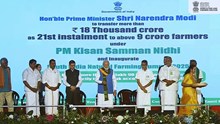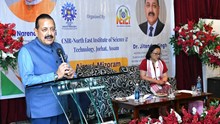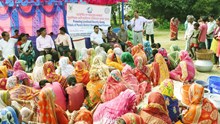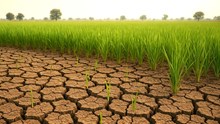
Chaitra Navratri, one of the most important festivals in Hindu culture, is a time of spiritual reflection, devotion, and fasting. It spans over nine nights, and fasting during this period is believed to purify the body and mind. However, fasting does not mean depriving yourself of nourishment. In fact, it’s an opportunity to fuel your body with wholesome, nutrient-rich foods that support both physical health and spiritual well-being. Whether you are following a strict fast or simply choosing to eat specific foods during this time, it is important to nourish your body with healthy, energizing ingredients.
This year's Chaitra Navratri 2025 begins on March 30th and ends on April 7th. This is a time when people across India and the world come together to celebrate the divine feminine and focus on spiritual growth. While fasting is an essential aspect of the festival, it’s also important to ensure your body remains energized and nourished. Below are some healthy food options that you can include in your Navratri fasting diet, along with their benefits:
1. Buckwheat (Kuttu)
Buckwheat is a gluten-free grain that is commonly consumed during Navratri. It is rich in fiber, protein, and essential minerals like magnesium. Buckwheat helps in maintaining energy levels throughout the day and promotes healthy digestion, making it an excellent food choice during fasting. You can enjoy buckwheat in the form of kuttu ka paratha, cheela, or kuttu flour porridge.
2. Barnyard Millet (Samak Rice)
Barnyard millet, often referred to as samak rice, is a gluten-free, fiber-packed grain that is light on the stomach and easy to digest. It is an excellent substitute for regular rice and is loaded with antioxidants that help cleanse the body. Barnyard millet can be used to prepare a healthy and filling khichdi, pulao, or even as a side dish with curd.
3. Water Chestnut Flour (Singhara Atta)
Singhara atta is made from water chestnuts and is a great source of potassium, iron, and fiber. It helps in digestion, keeps you full for longer periods, and provides a good amount of energy. Singhara atta is often used to make singhara flour pancakes or parathas, and it is also a common ingredient for preparing halwa or poorani during fasting.
4. Amaranth (Rajgira)
Amaranth, also known as rajgira, is a powerhouse of nutrients. It is rich in protein, calcium, and iron, which help maintain energy levels and support muscle recovery. Amaranth is often used to make rajgira parathas, pulao, and kheer during Navratri. Including amaranth in your fasting diet will strengthen your bones and muscles, making it a great choice for fasting.
5. Sabudana (Tapioca Pearls)
Sabudana, or tapioca pearls, is a popular food during Navratri fasting, known for providing instant energy. It is carbohydrate-rich and easy to digest, making it perfect for those who want to stay energized while fasting. Sabudana is often consumed in the form of sabudana khichdi, sabudana vada, or sabudana kheer. It keeps you full for a long time and prevents sluggishness.
6. Fox Nuts (Makhana)
Makhana, or fox nuts, are low in calories but high in protein, making them an ideal snack for fasting. They are rich in antioxidants, which help prevent aging and promote heart health. Makhana can be roasted and eaten as a snack, added to kheer, or included in a fruit salad. It’s a light yet nutritious option that will keep you feeling energized throughout the day.
7. Dairy Products
Dairy products such as milk, yogurt, and paneer are highly nutritious and a great source of protein and calcium. These foods help in maintaining muscle strength and keeping the body cool during the fasting period. Paneer tikka, dahi, or sweetened milk can be added to your diet to keep you feeling satisfied and energized.
8. Dry Fruits and Nuts
Almonds, walnuts, raisins, and cashews are an excellent source of essential fatty acids, proteins, and antioxidants. They keep you energized throughout the day and provide a quick source of energy. You can enjoy dry fruits as a snack or add them to your fruit chaat, sweet dishes, or smoothies. These will not only add nutrition to your meal but also keep your energy levels stable.
9. Fresh Fruits and Vegetables
Fruits like bananas, apples, and pomegranates provide natural sugars and vitamins, while vegetables like pumpkin, bottle gourd, and sweet potatoes are easy to digest and nutrient-rich. Including these fruits and vegetables in your diet can help balance electrolytes, support hydration, and provide essential vitamins and minerals. They are great for maintaining overall health during the fasting period.
Chaitra Navratri and the Benefits of Fasting
Chaitra Navratri, which falls during the beginning of the spring season, is considered highly auspicious. It is believed that fasting during this period helps purify the mind and body, as well as establish a deeper connection with the divine. Observing a fast during Navratri provides various benefits, both physically and mentally:
-
Detoxification: Fasting helps to detoxify the body by eliminating toxins and reducing the burden on the digestive system.
-
Improved Digestion: With a break from regular heavy meals, your digestive system gets a chance to rest and rejuvenate, improving overall digestion.
-
Mental Clarity: Fasting promotes focus and concentration, and many devotees report feeling more spiritually aligned during this time.
-
Boosted Immunity: Many fasting-friendly foods like fruits, nuts, and millets are packed with antioxidants and nutrients that help boost the immune system.
-
Energy and Vitality: Consuming the right nourishing foods during fasting ensures that you have sustained energy throughout the day, preventing fatigue and sluggishness.
By including these nutrient-dense foods in your Navratri fasting diet, you can maintain your energy levels and stay healthy while observing your fast. Choose wholesome ingredients to nourish your body and enjoy the festive spirit with vitality. This Chaitra Navratri, make sure your fasting is not just about restraint but also about taking care of your body and nourishing it with goodness. Happy fasting!
















